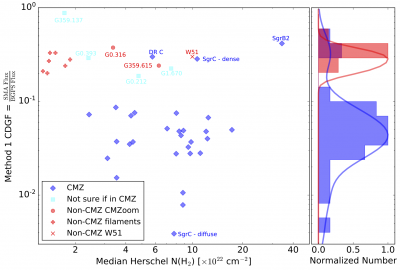The CMZoom Survey Overview paper is now published: https://ui.adsabs.harvard.edu/abs/2020ApJS..249…35B/abstract!
This paper presents the overview of the CMZoom survey, presents its first data release (data publicly available here: https://dataverse.harvard.edu/dataverse/cmzoom), and describes first key results.
CMZoom is the first complete and unbiased survey of dense gas in the Central Molecular Zone (CMZ: inner 500 pc of our Galaxy) at wavelengths that are sensitive to young, forming stars. CMZoom is a large survey (550 hours) on the Submillimeter Array (SMA) at 1.3 mm in dust continuum and spectral lines. CMZoom observed all of the highest column density gas (N(H2) > 1023 cm-2) in the CMZ and a few additional regions of interest. The spatial resolution of CMZoom is about 3″ or 0.1 pc at the distance of the Galactic Center. In this paper, we report on and release the dust continuum data (available here) but we also describe the observation and data reduction of the spectral line data, which will be released in a future publication (Callanan et al. in prep.)
This Figure shows an overview of the CMZoom dust continuum, thought to be tracing young, forming stars. The middle panel shows the full dust continuum emission over the entire survey, with zoom-ins toward select regions. The images are all on the same color scale.

While CMZoom detected many regions with rich and complex substructure, its key result is an overall deficit in compact substructures on 0.1-2 pc scales (the compact dense gas fraction: CDGF). In the figure below, the CDGF is shown on the y-axis and the column density on the x-axis. Colored in red are sources in the Galactic disk and in blue are CMZ sources. In comparison with clouds in the Galactic disk, the CDGF in the CMZ is substantially lower, despite having much higher average column densities. CMZ clouds with high CDGFs are well-known sites of active star formation.

The inability of most gas in the CMZ to form compact substructures is likely responsible for the dearth of star formation in the CMZ, surprising considering its high density. The factors responsible for the low CDGF are not yet understood but are plausibly due to the extreme environment of the CMZ, having far-reaching ramifications for our understanding of the star formation process across the cosmos.